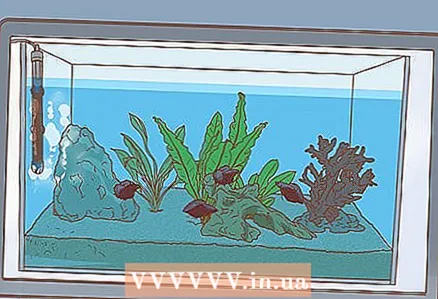
Content
- Steps
- Part 1 of 3: Determine the capacity of your aquarium
- Part 2 of 3: Determine Which Fish to Keep Together
- Part 3 of 3: Keep an eye on the health of your aquarium
- Tips
- Warnings
Increasing the fish population in an aquarium is both a science and an art. The goal itself, as a rule, is to find out how many fish can fit in the aquarium without overpopulating it. This indicator is influenced by several factors. Do a little research to find out how many fish can be in the aquarium at the same time.
Steps
Part 1 of 3: Determine the capacity of your aquarium
 1 Calculate the volume of the aquarium. The volume of an aquarium is usually measured in liters. You can find out the size of the aquarium when you buy it. But if you do not know (or do not remember) its size, you can calculate the volume mathematically.
1 Calculate the volume of the aquarium. The volume of an aquarium is usually measured in liters. You can find out the size of the aquarium when you buy it. But if you do not know (or do not remember) its size, you can calculate the volume mathematically. - To find out the volume of an aquarium, you need to measure its length, width and height in centimeters, then multiply and divide by 1000. This number will be approximate, since the actual volume will be underestimated due to the thickness of glass, substrate, decorations and other elements.
- 2 Observe the correct water level. Maintain the water at the correct level to accurately calculate how many fish will fit in the aquarium. If the water level is too low, the aquarium will not hold many fish. Typically, the water should be about 3 cm above the edge of the water filter.
Advice: note that displacement is also an important factor. If your aquarium contains many different decorations, you will not be able to accommodate as many fish as you would in an unadorned aquarium.
 3 Use the rule that 2.5 cm of fish fits in 4 liters of water. It is worth noting that this rule does not always work. For example, a fish that is 25 cm long cannot live in a 40 liter aquarium.
3 Use the rule that 2.5 cm of fish fits in 4 liters of water. It is worth noting that this rule does not always work. For example, a fish that is 25 cm long cannot live in a 40 liter aquarium. - These tips are best for small, peaceful fish such as tetras, iris, platy and others.
- Study the fish you want to buy to see how big your tank should be.
 4 Use the area rule. Since it is on the surface of the water that gas exchange takes place, which supports the vital activity of the fish, this must be taken into account when filling the aquarium. Larger area means more oxygen exchange for fish.
4 Use the area rule. Since it is on the surface of the water that gas exchange takes place, which supports the vital activity of the fish, this must be taken into account when filling the aquarium. Larger area means more oxygen exchange for fish. - A tall aquarium with the same surface area as a low one cannot hold more fish, although it technically holds more water.
- As a rule of thumb, this rule is best used when determining the number of fish in an aquarium, as it takes into account the amount of oxygen the fish needs, not just the available space.
Part 2 of 3: Determine Which Fish to Keep Together
 1 Decide which fish to start. Are you looking for a community of many small fish? In this case, consider buying minnows and tetras. Want a semi-aggressive community of several big fish? Alternatively, you can take angel fish or cichlids. Or do you just need one big fish like the ocular astronotus? Browse through the options available to find what you like, and then research as closely as possible the compatibility between fish and size restrictions.
1 Decide which fish to start. Are you looking for a community of many small fish? In this case, consider buying minnows and tetras. Want a semi-aggressive community of several big fish? Alternatively, you can take angel fish or cichlids. Or do you just need one big fish like the ocular astronotus? Browse through the options available to find what you like, and then research as closely as possible the compatibility between fish and size restrictions. - Some fish are more aggressive than others and need more space, while others thrive in large concentrations of fish. Do your research before populating your tank with fish.
Consider the number of fish. For a community of small fish (less than 8 cm), 2.5 cm of fish per 4 L of water is a good guideline. Determining the optimal number of larger fish can be tricky. If you consider that you did not include fish that will be too large for the aquarium or that cannot be kept with the rest of the fish on your list, we recommend starting with 2.5 cm for every 7.5 liters of water and observing the result.
Advice: do not forget that the fish will still grow.
- 1
- Try to find a balance between the number of fish at the top, middle and bottom. In other words, you need to consider where your chosen fish like to swim. For example, the plecostomus loves to be at the bottom, while the wedge-bellies float at the top.
 2 Find out about the needs of each fish. Study the individual characteristics of each fish you want to place in the aquarium. Each fish needs something specific to be happy.
2 Find out about the needs of each fish. Study the individual characteristics of each fish you want to place in the aquarium. Each fish needs something specific to be happy. - Some of them make a big mess, others are aggressive, and still others are nocturnal. Find information from various sources to learn about the behavior of the fish.
 3 Learn about your oxygen requirements. Different types of fish have different oxygen requirements. Fat goldfish need more oxygen than slender fish like tetras. If you are populating mainly large fish, they will need more oxygen (and therefore more space in the aquarium) than small ones.
3 Learn about your oxygen requirements. Different types of fish have different oxygen requirements. Fat goldfish need more oxygen than slender fish like tetras. If you are populating mainly large fish, they will need more oxygen (and therefore more space in the aquarium) than small ones. - Use air stones and filters to oxygenate the water.
- To determine the optimal number of fish, the size / weight of adult fish must be taken into account to calculate the required oxygen as they grow. If you bought young animals, then when determining the number of fish that need to be placed in the aquarium, be sure to take into account their future sizes (and how much oxygen an adult will need).
Part 3 of 3: Keep an eye on the health of your aquarium
Install the optimal filtration system. Dirty fish and large numbers of fish require a better filtration system, so the larger the filter, the better. The filter will keep the aquarium clean and the water clear to keep your fish from getting sick.
Advice: Know which filter is recommended for your aquarium and use 1–2 sizes larger, especially if you have populated the aquarium with as many fish as possible.
- 1
- Wedge-bellies and fighting fish need a weak filter. Fish like loaches, goldfish, and ocellated astronotuses need a powerful filter.
 2 Feed your fish on schedule. Overfeeding your fish will make your aquarium dirtier and more difficult to maintain. This will ultimately lead to a decrease in the number of fish that can be safely kept in the aquarium.
2 Feed your fish on schedule. Overfeeding your fish will make your aquarium dirtier and more difficult to maintain. This will ultimately lead to a decrease in the number of fish that can be safely kept in the aquarium. - As a general rule, the fish should be given one eye-sized serving. This amount of food can also be given twice a day, but after studying both methods, it has been proven that a one-time meal is more beneficial.
- Overfeeding can also lead to high ammonia and nitrate levels, disease, poor digestion in the aquarium dwellers and muddy waters.
 3 Clean your aquarium regularly. A dirty aquarium can cause a lot of trouble for your fish. Fish can get sick, feel uncomfortable, or even die. The dirtier the aquarium, the fewer fish can be kept in it (due to inadequate oxygen levels and filtration problems). As a general rule, even with a good filtration system, the aquarium should be washed once a week.
3 Clean your aquarium regularly. A dirty aquarium can cause a lot of trouble for your fish. Fish can get sick, feel uncomfortable, or even die. The dirtier the aquarium, the fewer fish can be kept in it (due to inadequate oxygen levels and filtration problems). As a general rule, even with a good filtration system, the aquarium should be washed once a week. - Read the article How to Clean Your Fish Tank.
Tips
- The growth of the fish is not limited to the size of the aquarium, so if you are told that a plekostomus from 2.5 cm will grow to 60 cm - be sure of it!
- Before you buy fish for your aquarium, make a list and study all the fish you want to take.
Warnings
- Overcrowding can lead to confusion, aggression, disease and poor water quality. Avoid this at all costs, even if you see a similar situation at the pet store.
- Some fish create more mud than others, which can lead to a decrease in the optimal number of fish in the aquarium.
- Many fish grow very large. Don't buy fish you don't know anything about.



